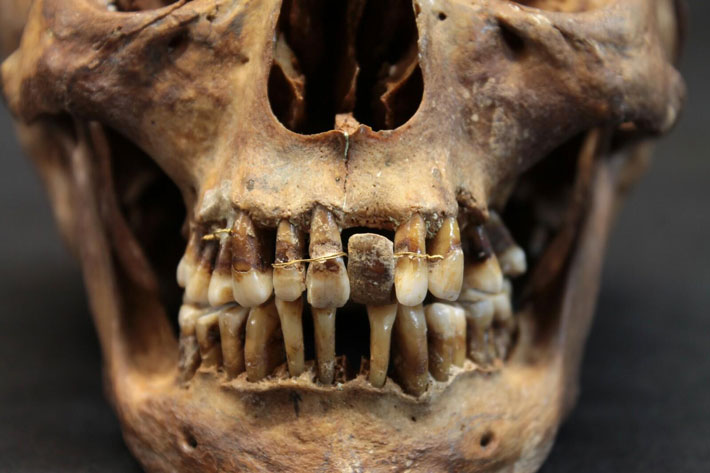 LAVAL, FRANCE—CBS News reports that archaeologists led by Rozenn Colleter of the France's National Institute of Preventive Archaeological Research (INRAP) have used a cone beam scan to examine the dental work of Anne d’Alègre, an aristocrat who died in 1619 and was buried in a lead coffin at the Chateau de Laval in northwestern France. When the X-rays were compiled into 3-D images, the researchers found that the woman suffered from periodontal disease that had loosened her teeth. A gold wire had been used to link the loose teeth to neighboring teeth. Over time, repeated tightening of the gold wire would have destabilized the neighboring teeth as well, Colleter explained. The researchers also identified an artificial tooth made of elephant ivory held in place by the wire. Hippo ivory was usually used in dental work at the time, Colleter concluded. To read about the oldest example of filling dental cavities, go to "Not So Pearly Whites."
LAVAL, FRANCE—CBS News reports that archaeologists led by Rozenn Colleter of the France's National Institute of Preventive Archaeological Research (INRAP) have used a cone beam scan to examine the dental work of Anne d’Alègre, an aristocrat who died in 1619 and was buried in a lead coffin at the Chateau de Laval in northwestern France. When the X-rays were compiled into 3-D images, the researchers found that the woman suffered from periodontal disease that had loosened her teeth. A gold wire had been used to link the loose teeth to neighboring teeth. Over time, repeated tightening of the gold wire would have destabilized the neighboring teeth as well, Colleter explained. The researchers also identified an artificial tooth made of elephant ivory held in place by the wire. Hippo ivory was usually used in dental work at the time, Colleter concluded. To read about the oldest example of filling dental cavities, go to "Not So Pearly Whites."
High-Tech Scans Reveal 17th-Century Dental Work
